This Custard Cake consists of ridiculously fluffy vanilla sponge cake layered with custard buttercream and a homemade custard filling.
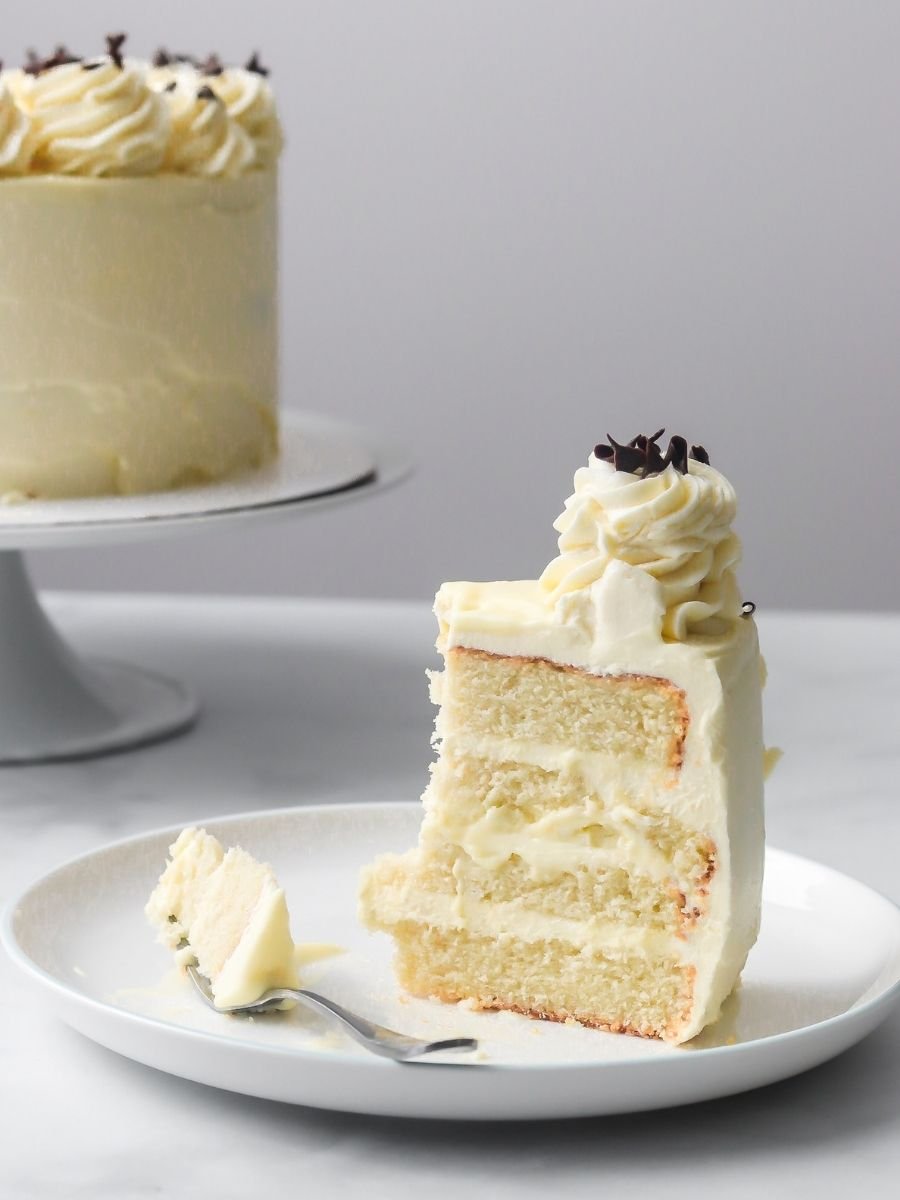
This is a magical 'proposal-inducing' custard cake it seems. I brought Chris a slice of it to try last week and the next morning - boom! An engagement ring.
Clearly, it was the cake.
I went through a few iterations of this vanilla custard cake and wasn't happy with it - so I broke it down and analyzed every step of the recipe until it was PERFECT. I switched to a reverse creaming method to make the sponge extra light and fluffy, and I changed the frosting recipe to make it even more custardy.
The cake uses custard (vanilla pastry cream, or crème patissière) in two ways, in the frosting to make a custard buttercream, and as a filling inside and on top of the cake. This is the same custard filling recipe I use in my Custard Donuts and it's always a winner!
Jump to:
- Custard Cake Ingredients
- How To Make Custard Cake
- Make the Custard Filling
- Make the Vanilla Sponge Cake
- Make the Custard Buttercream
- Assemble the Custard Cake
- Video - Custard Cake Tutorial
- What is the Reverse Creaming Method?
- What makes this Custard Cake Custardy?
- How To Store Custard Cake
- More Custard Dessert Recipes
- Recipe
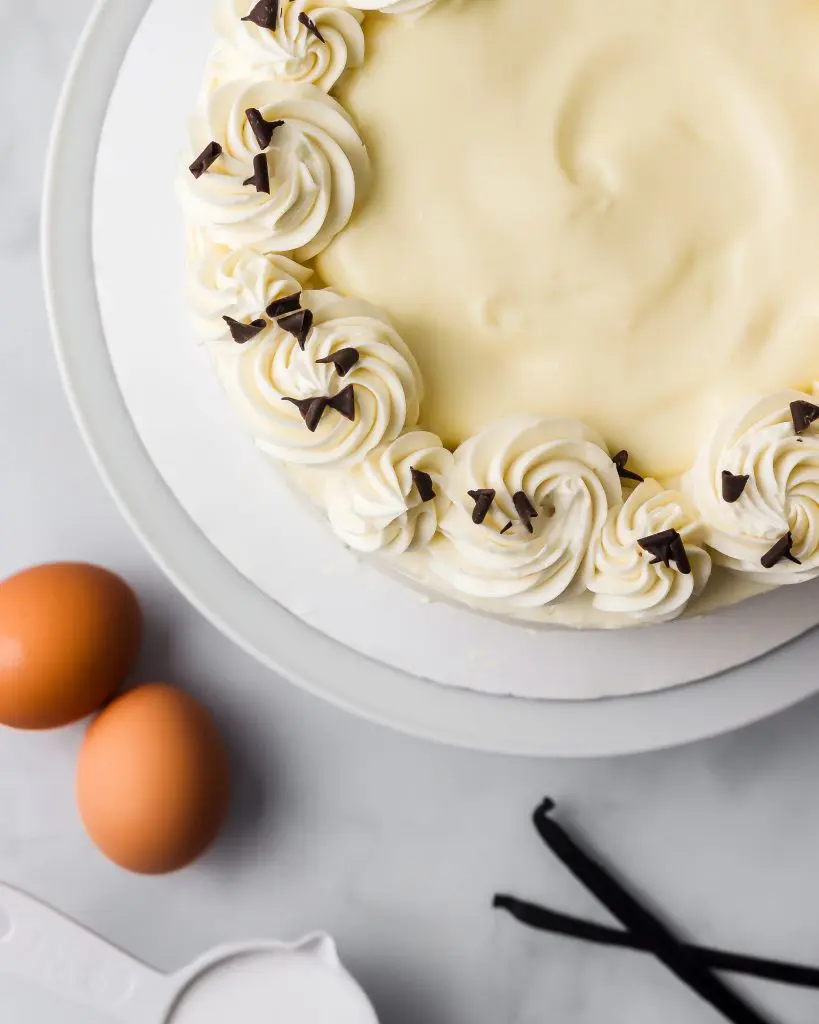
Reader Review:
I made this cake for my birthday last month and I have to say it's the best cake that I've ever made! I've used the reverse creaming method a lot but there's something about this recipe that is just perfect. The cake was so soft and moist. The German buttercream (my first time making it) was absolutely delicious and my new favorite buttercream! Add to that the pastry cream? It's the perfect cake! Thank you so much for this recipe!
⭐⭐⭐⭐⭐ - Brianna M
Custard Cake Ingredients
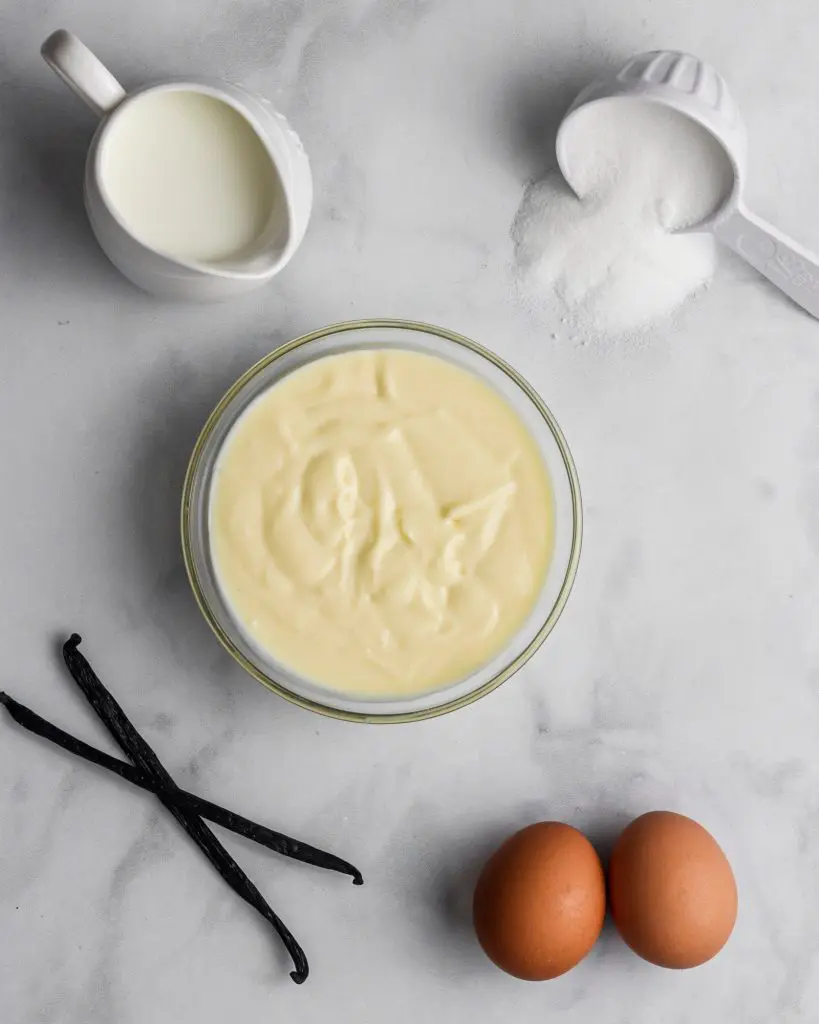
- Milk - For best results, use full-fat milk. Milk is the foundation of the custard and if you don't use a full-fat milk, you will not get that gorgeous, thick, creamy texture that makes custard custard. And you really can't have a custard cake with mediocre custard!
- Butter - The quality of the butter is important in this recipe, try to use something with a high fat percentage. Also, make sure the butter is at room temperature before beginning.
- Sugar - Superfine white sugar is best (caster sugar in the UK). Regular white sugar will also work fine if you can find superfine.
- Eggs - You will need egg yolks for the custard and whole eggs for the vanilla sponge. Save your leftover egg whites for another recipe, like my Strawberry Angel Food Cake.
- Vanilla - Of course, vanilla is an important ingredient as the cake, buttercream, and custard filling all revolve around it! Try to use a high-quality vanilla extract or vanilla bean paste, or if you like you can even use whole vanilla pods. The quality of the vanilla you use will really shine through in this recipe.
- Corn Starch - The cornstarch helps to thicken the pastry cream.
- Flour - This vanilla sponge works best with cake flour, but you can also use all-purpose flour if you don't have cake flour.
- Vegetable Oil - This helps to keep the cake moist, you can also use any flavorless oil you like.
- Powdered Sugar - This is optional to sweeten the custard buttercream, you can leave it out or add less of it if you prefer a less sweet frosting.
It's worth noting that, as always, it is crucial that your 'cold ingredients' (i.e. butter, milk, eggs) are brought to room temperature before starting this bake. There are a number of components that could curdle or go wrong easily, so make it easier on yourself and keep everything at the same temperature!
See the recipe card for the full recipe.
Recommended Equipment
How To Make Custard Cake
There are three elements to this vanilla custard cake - the French Vanilla Cake, the Custard Filling, and the Custard Buttercream. We'll use the custard filling (pastry cream) as a straight filling, and also to make the custard buttercream.
Make the Custard Filling
The first step for making this cake is to make the pastry cream - also known as crème pâtissière or custard. You can make the custard a day or two in advance if you want to break the recipe into easier steps. This is the same filling used inside Boston Cream Pie, so you know it's good!
- Whisk the egg yolks, sugar and cornstarch together in a large bowl until pale and thick.
- Heat the milk and vanilla in a medium saucepan and slowly warm over medium heat until scalding. This means that steam is rising from the milk, and tiny bubbles will start to appear on the surface. Don't let it boil.
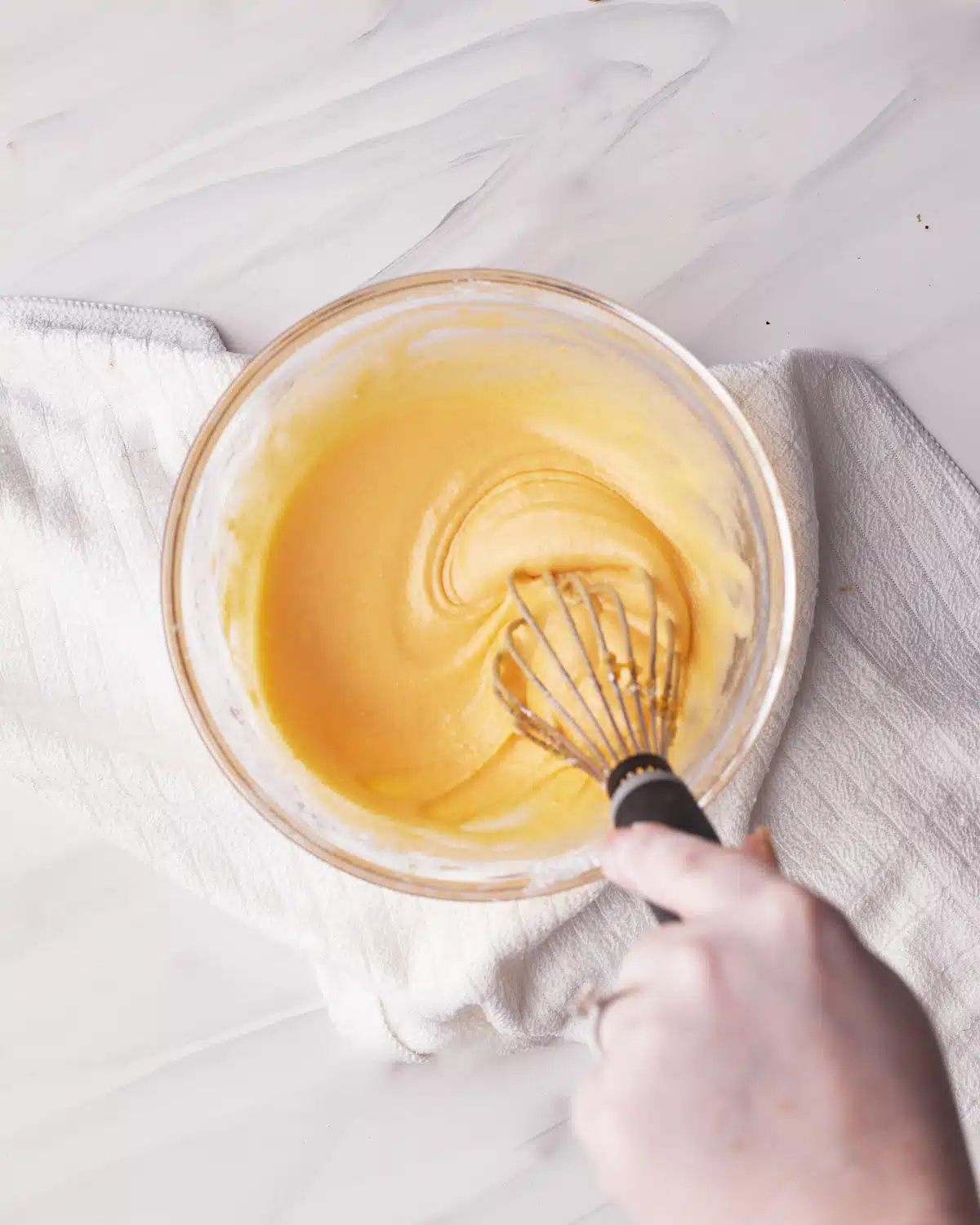
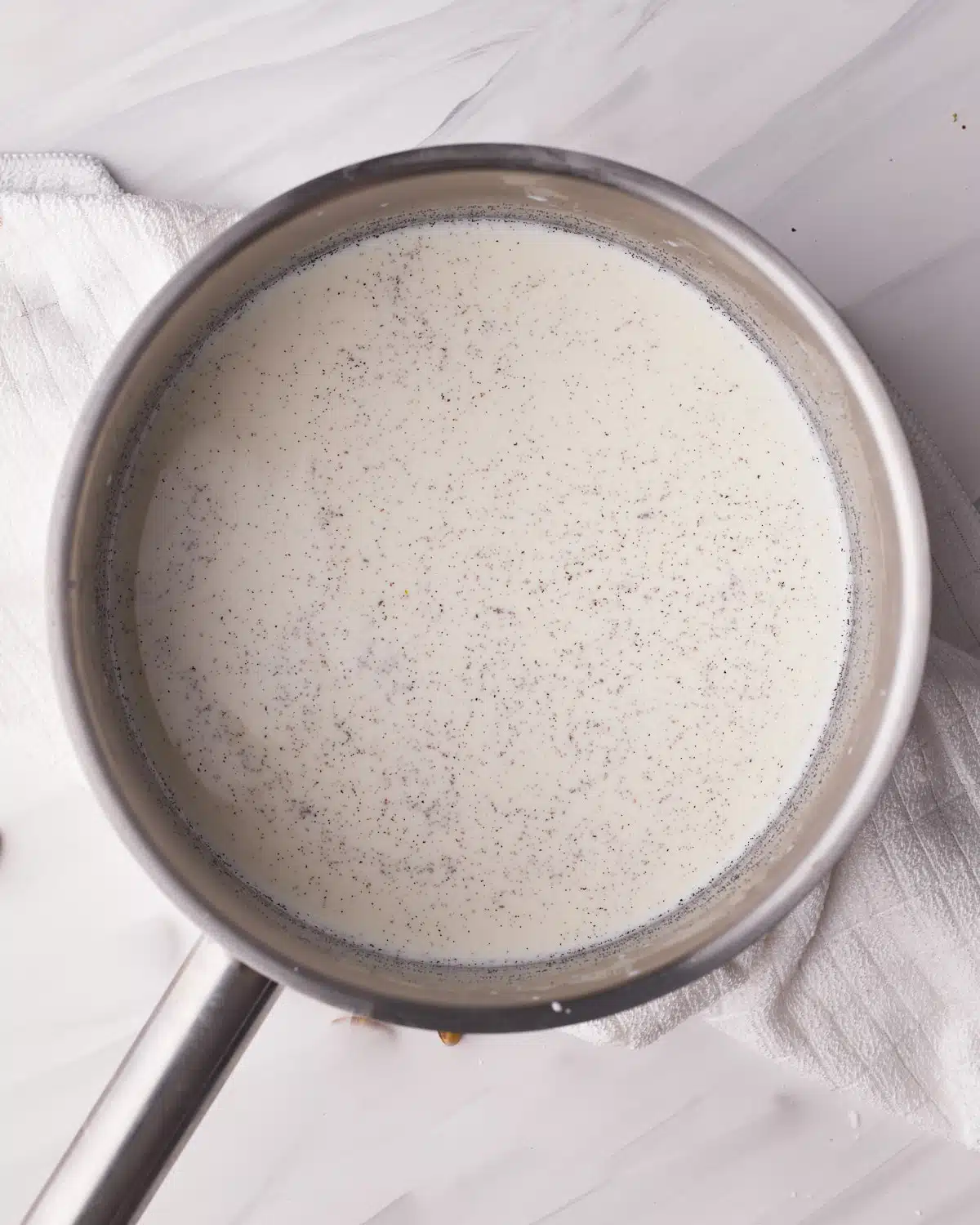
- Once the milk is scalding, drizzle a small amount of warm milk into the egg yolk mixture and whisk, then add a little more, repeat until everything is together in the bowl, then pour the whole mixture back into the saucepan.
It's important to add the milk to the eggs slowly to temper the eggs and prevent them from scrambling.
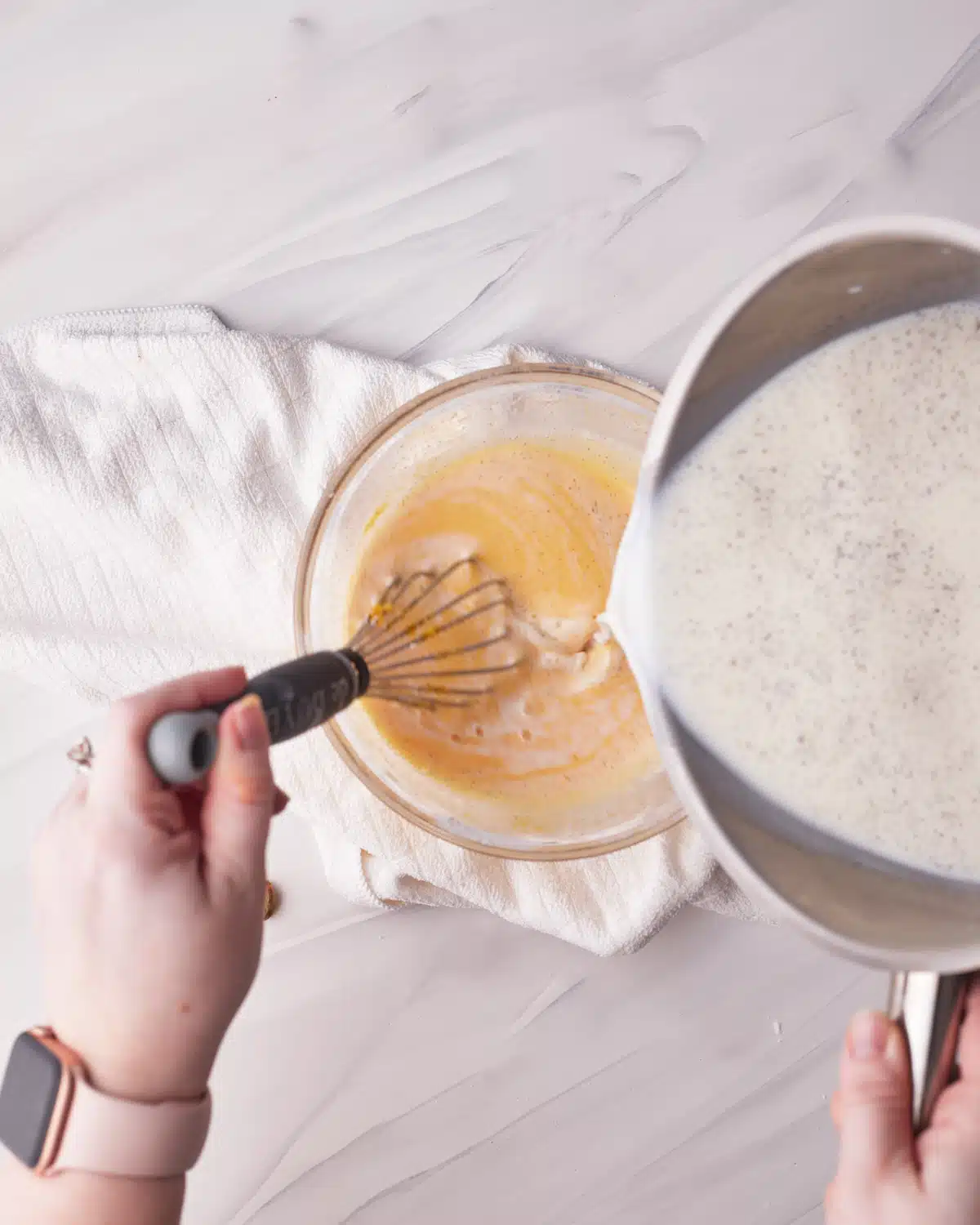
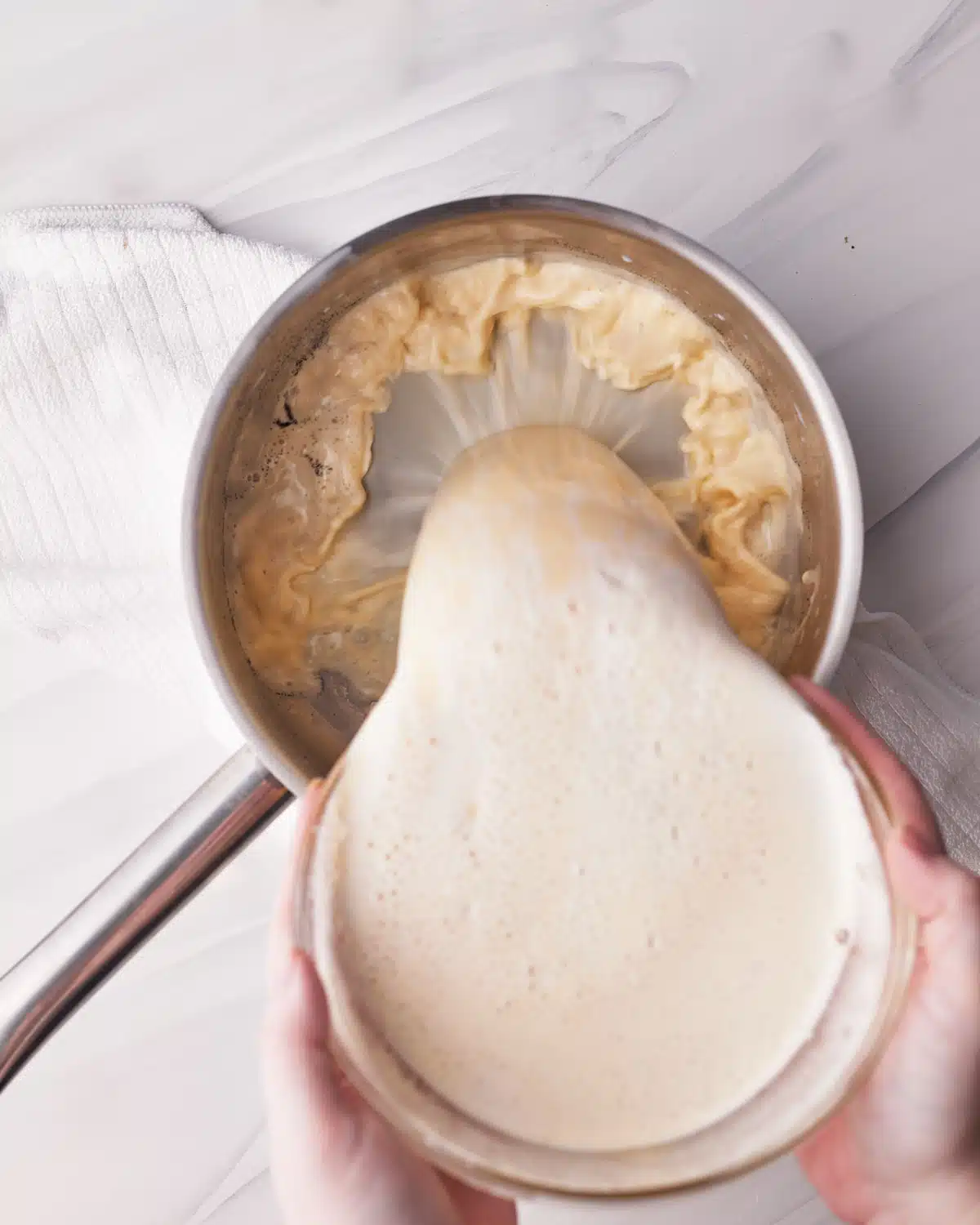
- Keep heating the custard on medium heat, whisking constantly until it begins to boil with thick bubbles bursting on the surface. Boil for 1-2 minutes. Remove from the heat. It should be thick enough that you can draw a line in it on the back of a spoon.
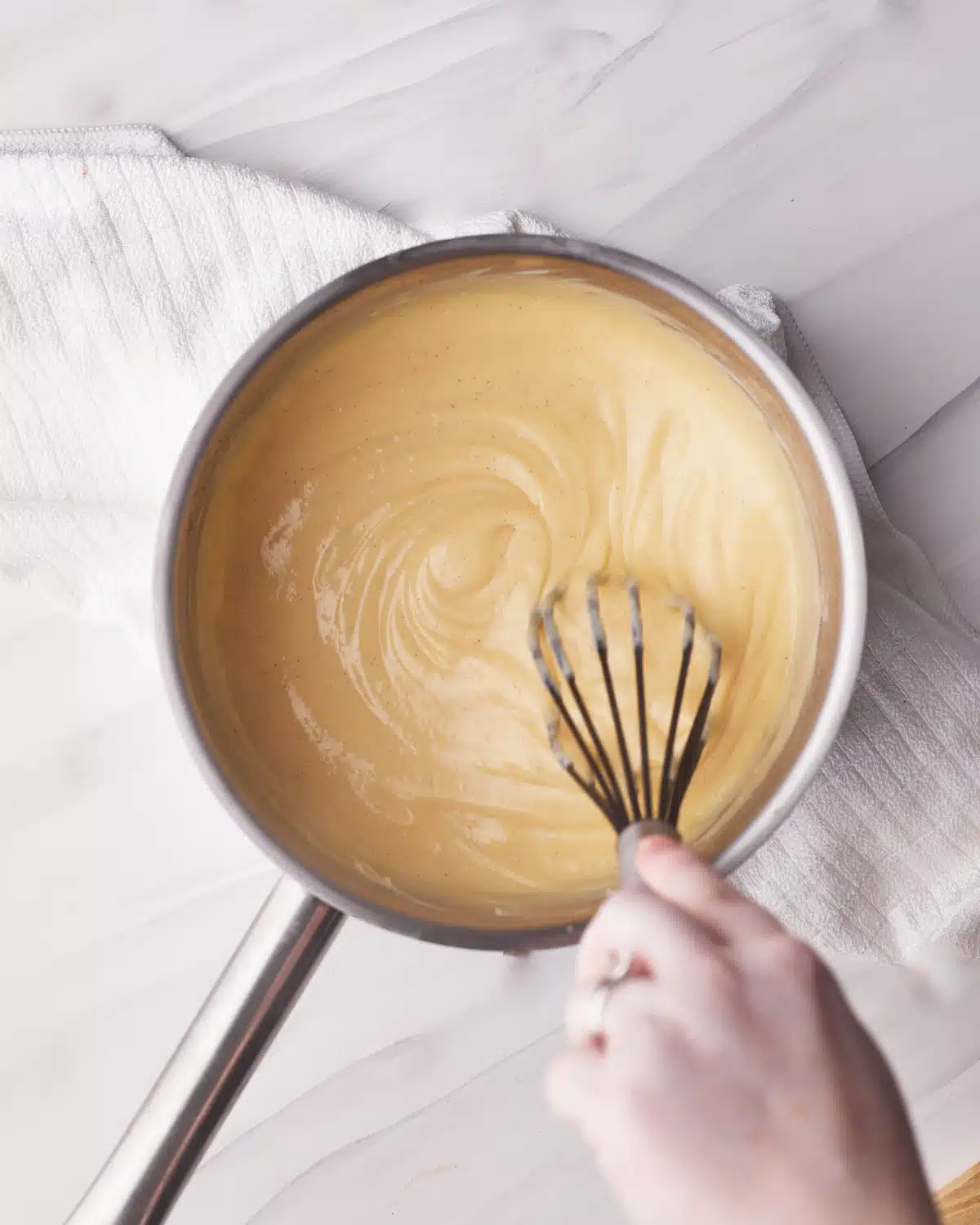
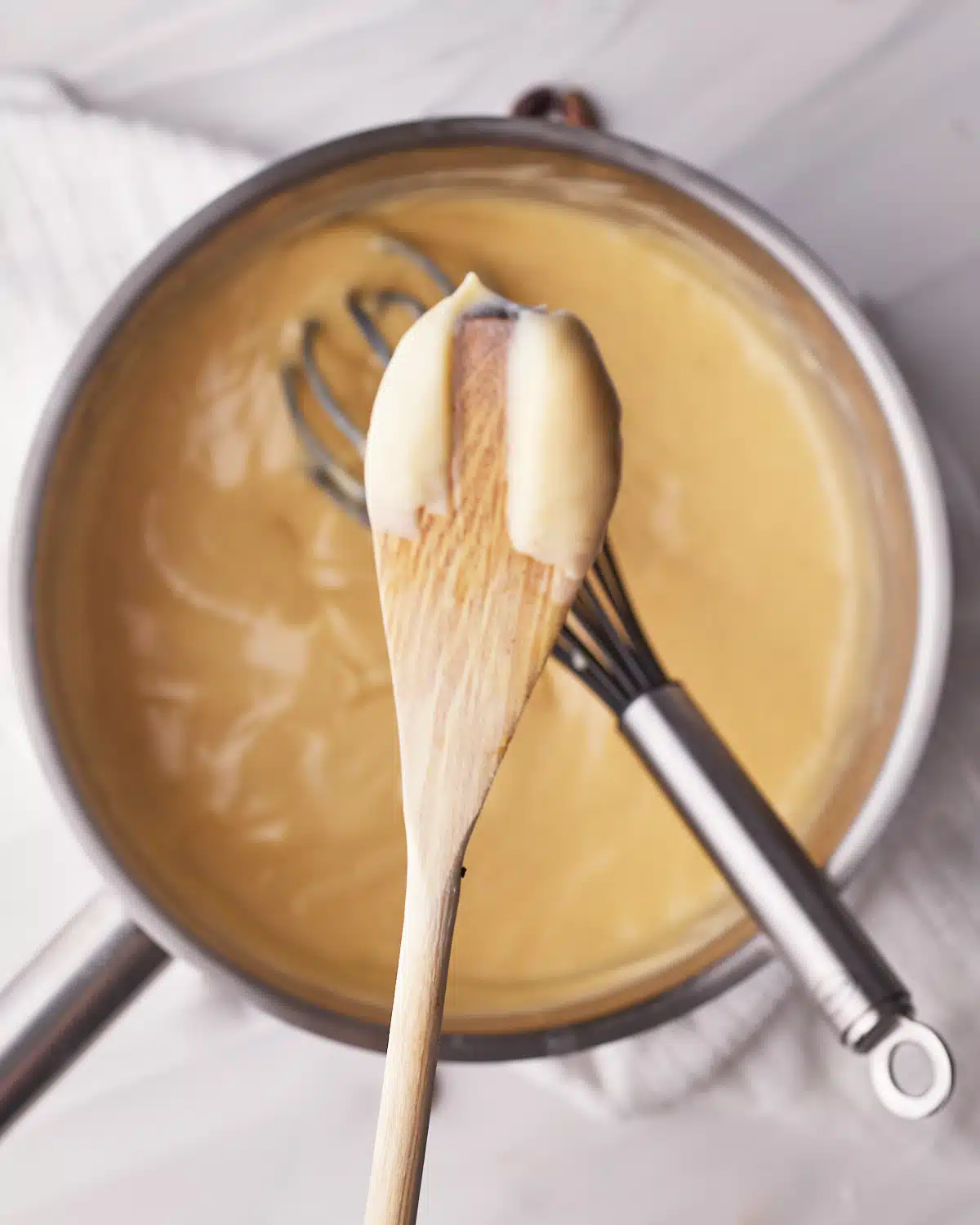
- If the custard has been cooked gradually, there shouldn't be any lumps in the custard, but if there are, you can pass the pastry cream through a sieve into a bowl to remove them.
- To enrich the pastry cream, whisk in the butter one small piece at a time, making sure it melts into the mixture completely before adding the next piece.
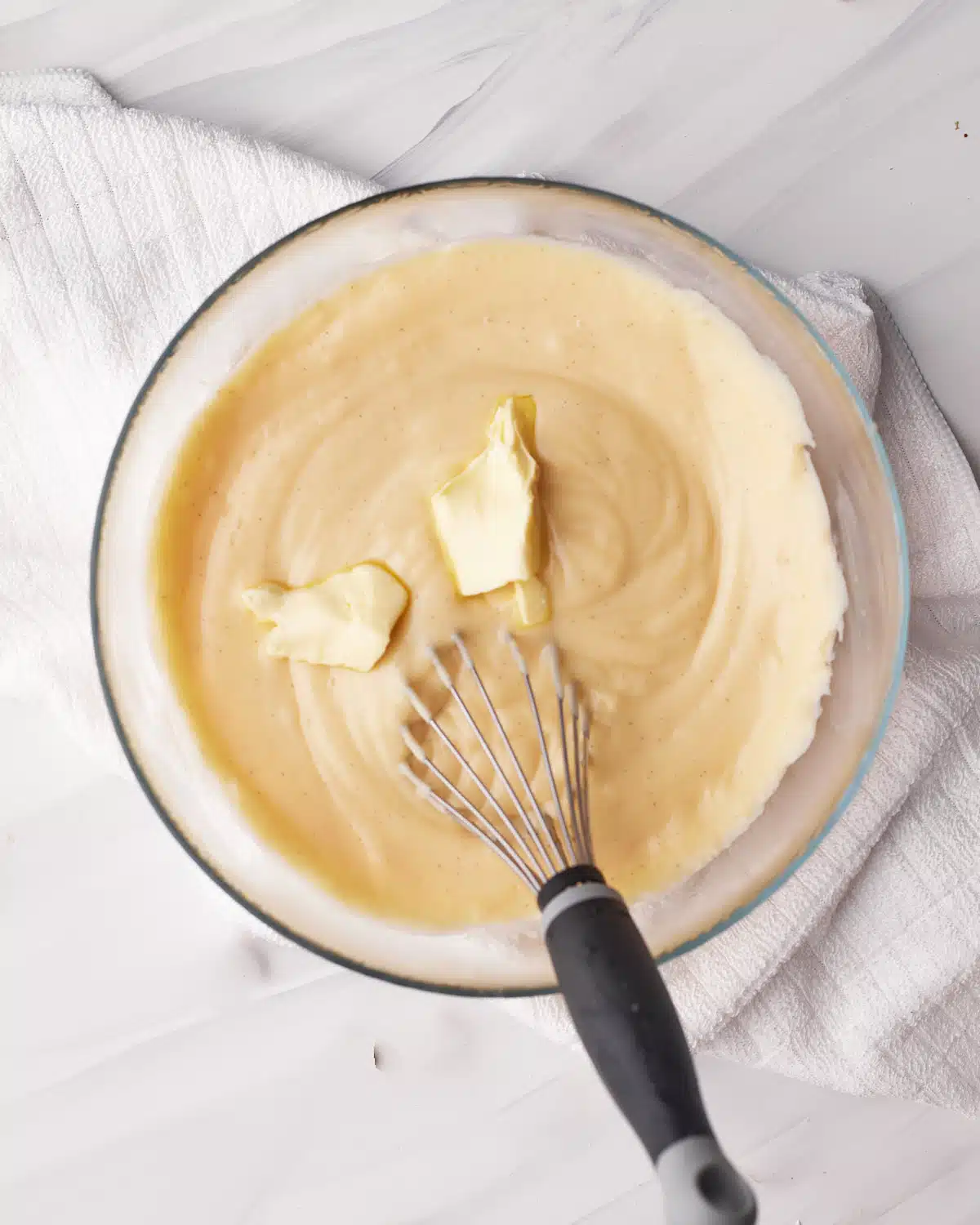
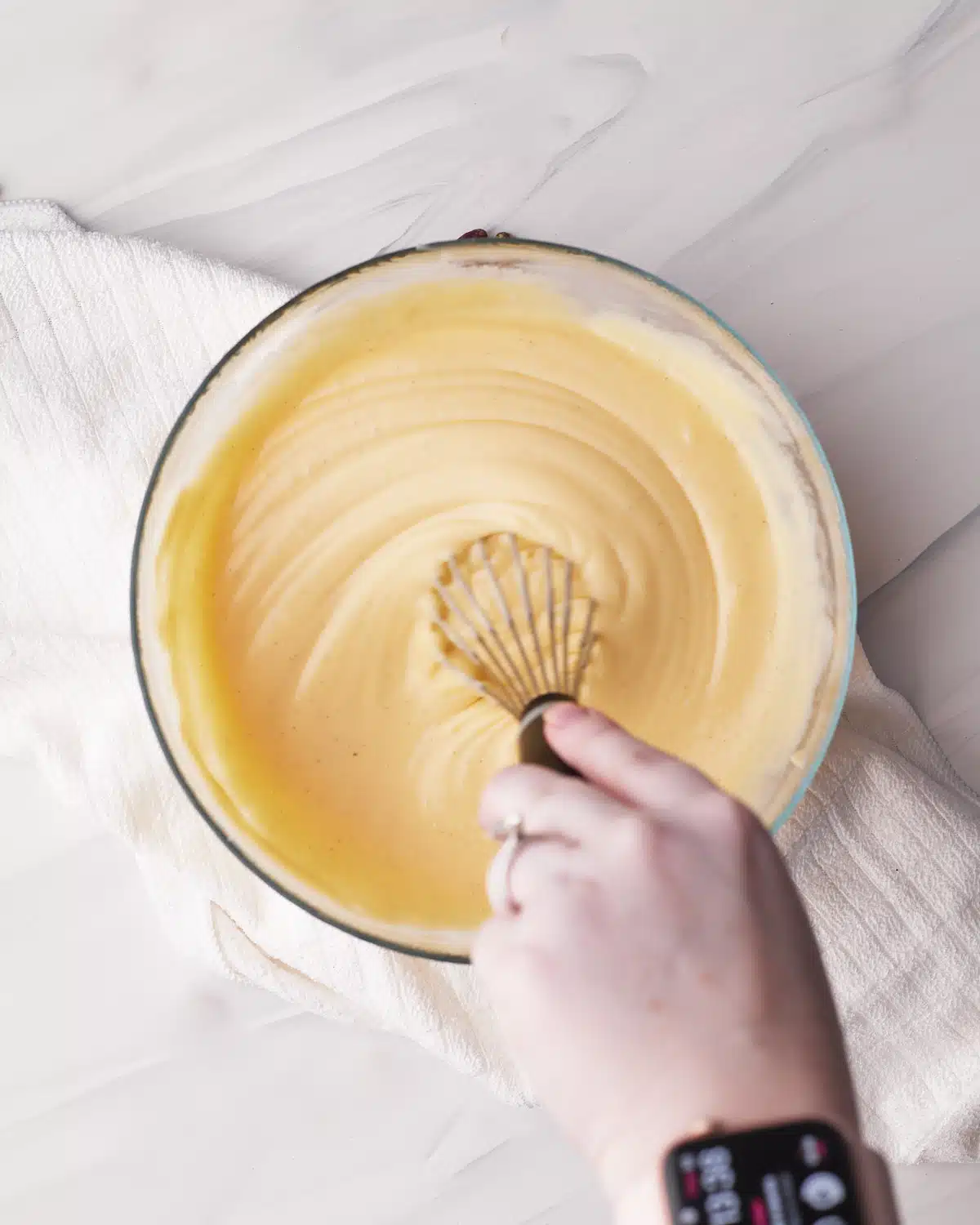
- Cover with plastic wrap (make sure the plastic wrap is touching the surface of the pastry cream to prevent skin from forming). Let it cool down a little and then refrigerate for at least two hours. I like to make this the day before and let it sit overnight, but it can be used after 2 hours.
Make the Vanilla Sponge Cake
This is my go-to Vanilla Cake recipe - I use it as a base for lots of other cakes and cupcakes. If you want to make an even lighter version, try my Genoise Sponge.
- Preheat oven to 350°F / 180°C (or 160°C for a fan-assisted oven) and grease two 8-inch cake pans.
- Split the milk into two containers, one with ½ cup of milk (120ml) and one with ¾ cup of milk (180ml).
- Mix the ½ cup of milk with the vegetable oil and set aside. Mix the ¾ cup of milk with the eggs and vanilla. Whisk together lightly and set aside.
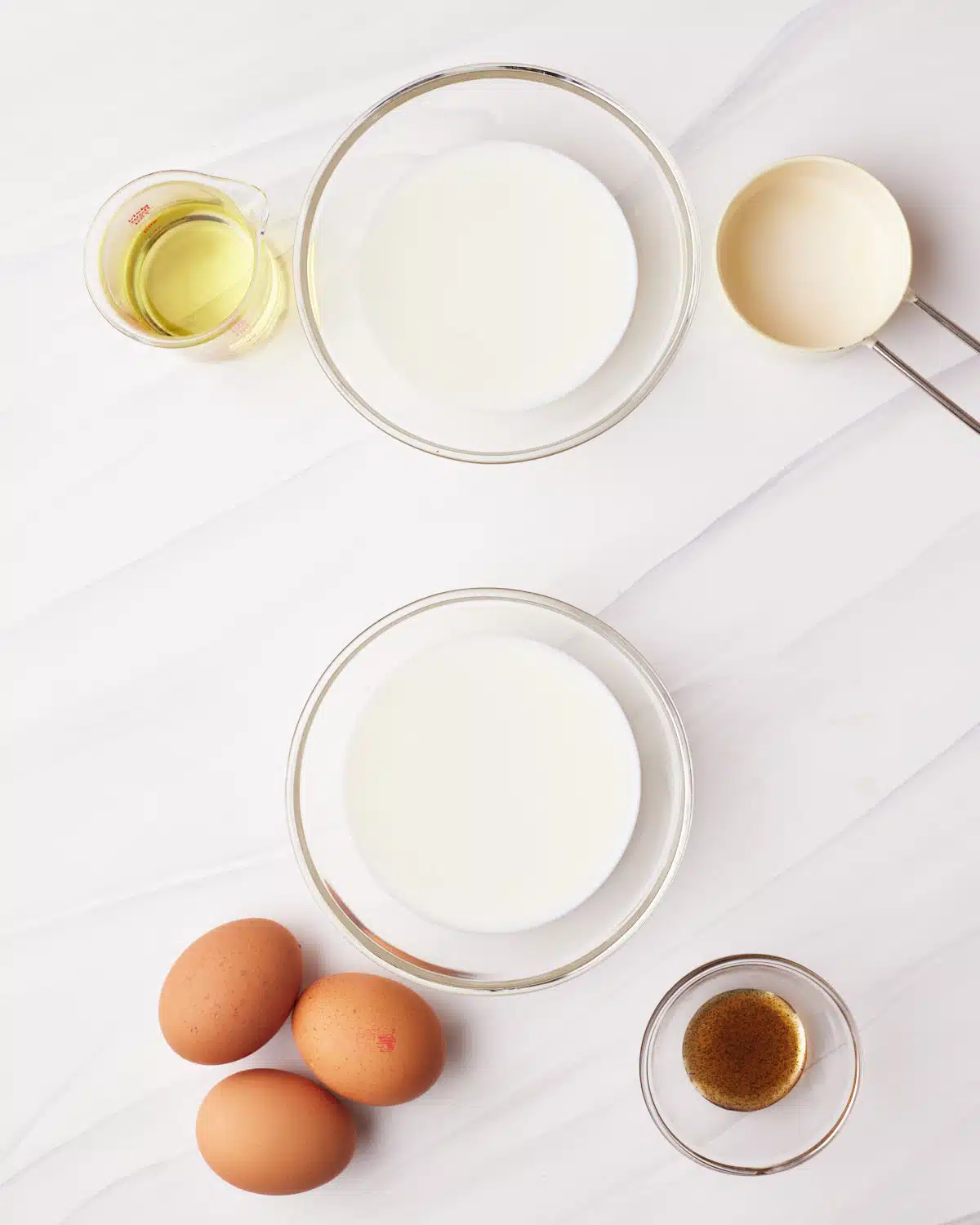
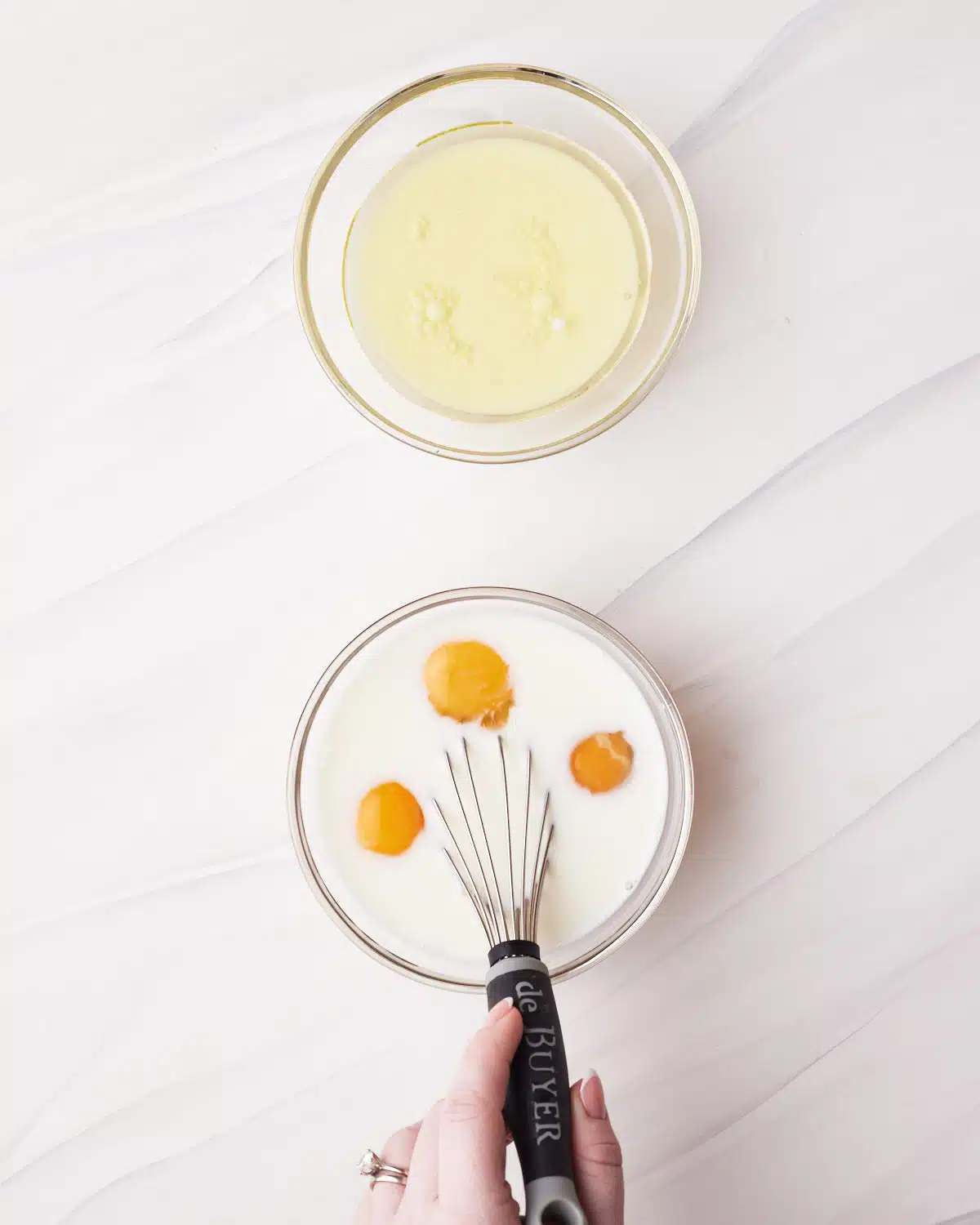
- Sift the flour, sugar, baking powder, and salt into the bowl of your mixer and turn on low with your paddle attachment.
- Slowly add the butter, one small chunk at a time, letting it mix for a few seconds in between additions. Once it's all in it should look kind of like chunky breadcrumbs.
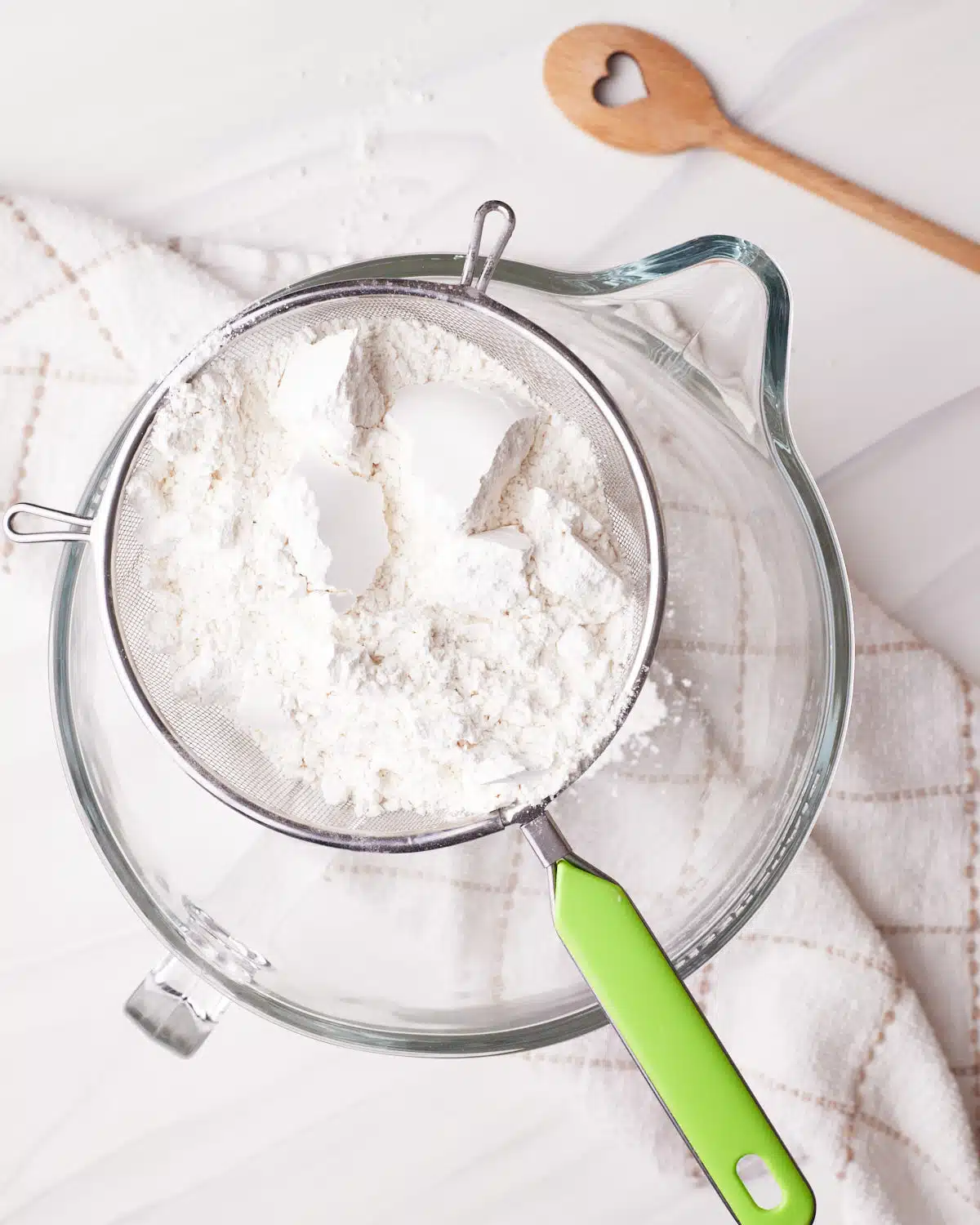
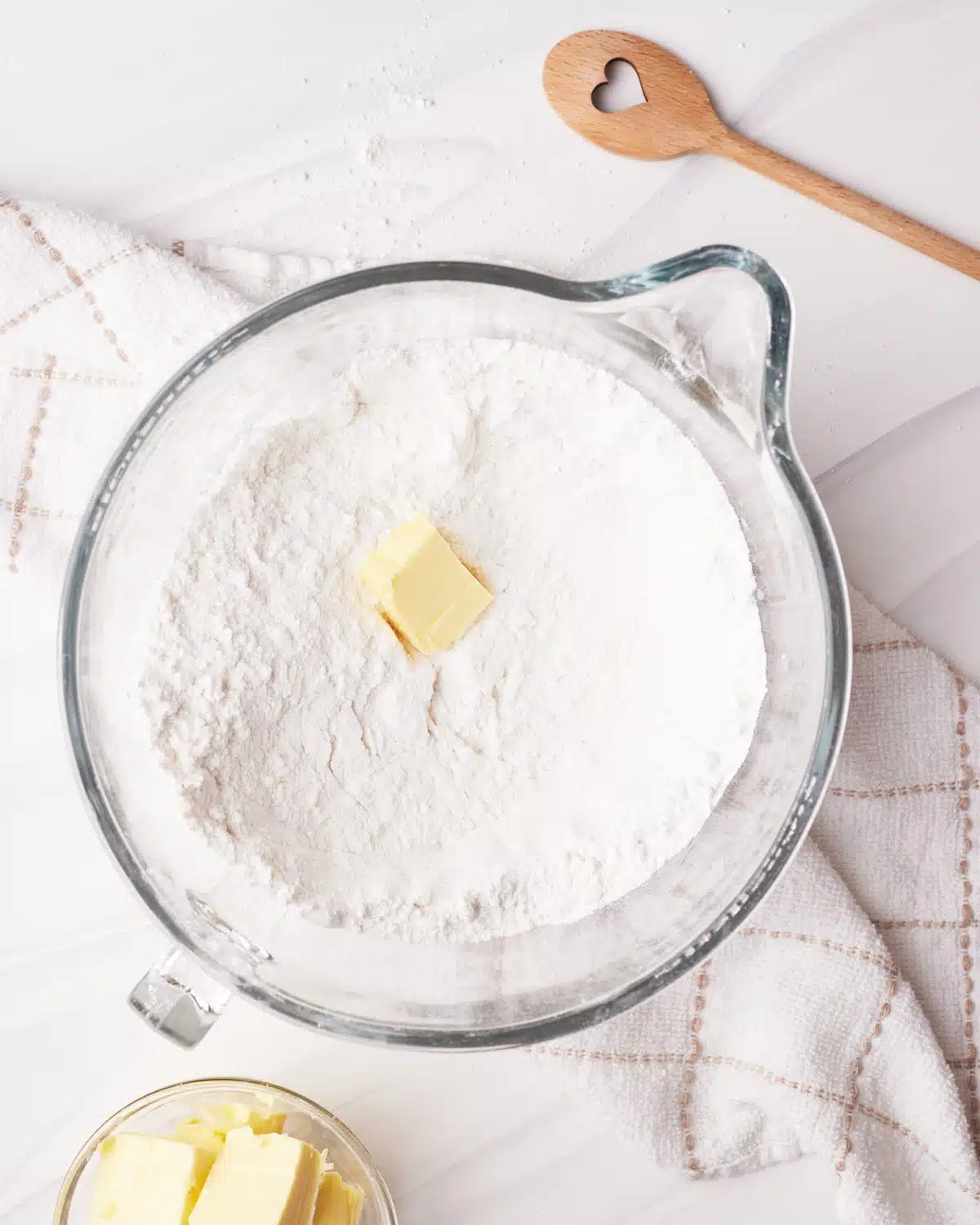
- Add the milk/oil mixture and slowly turn your mixer up to a medium speed, just so it doesn't splash. Beat for exactly two minutes.
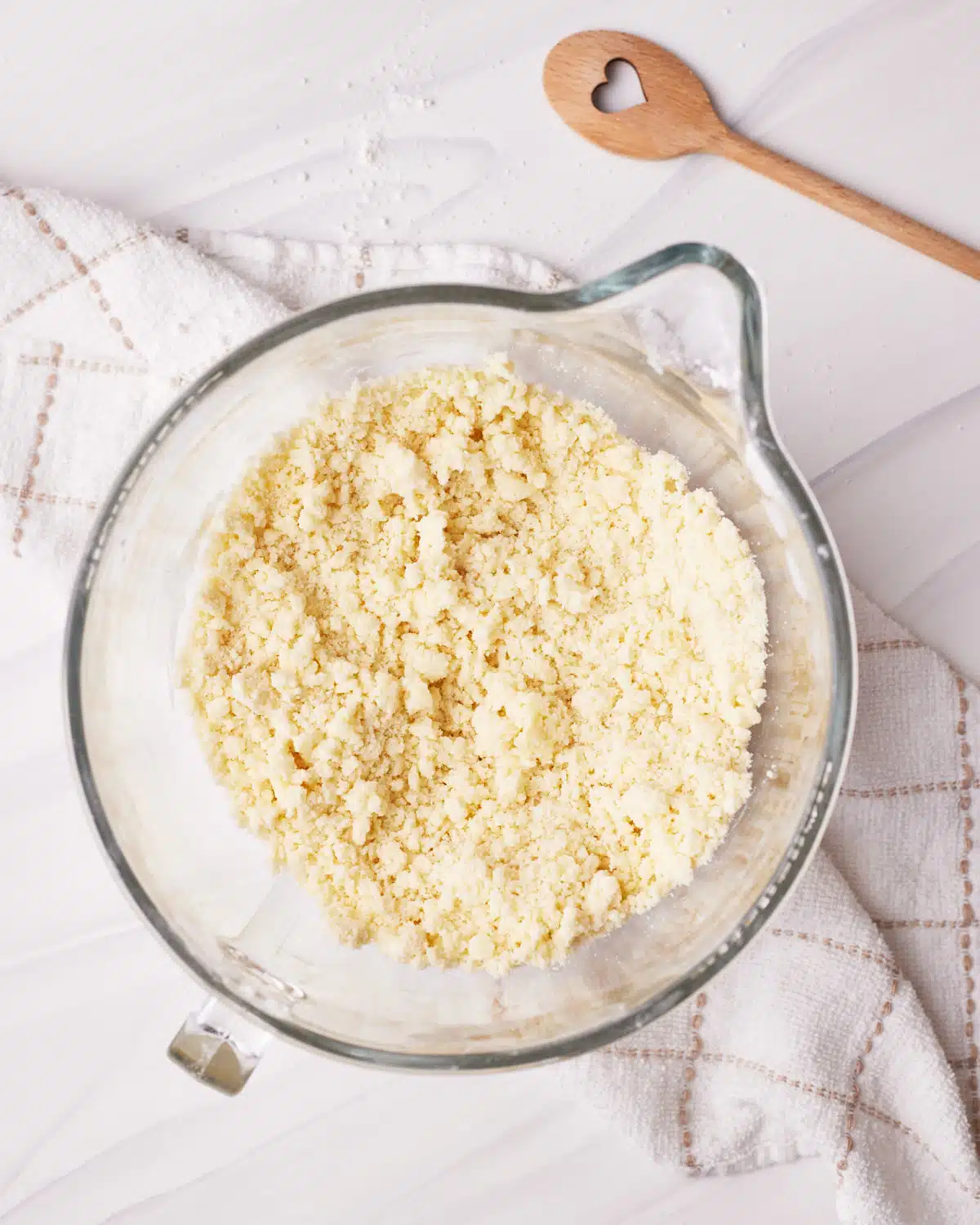

- Scrape the sides of your bowl to make sure there are no lumps, then turn the mixer back on low.
- Add the milk/egg mixture slowly and mix on low until just combined.
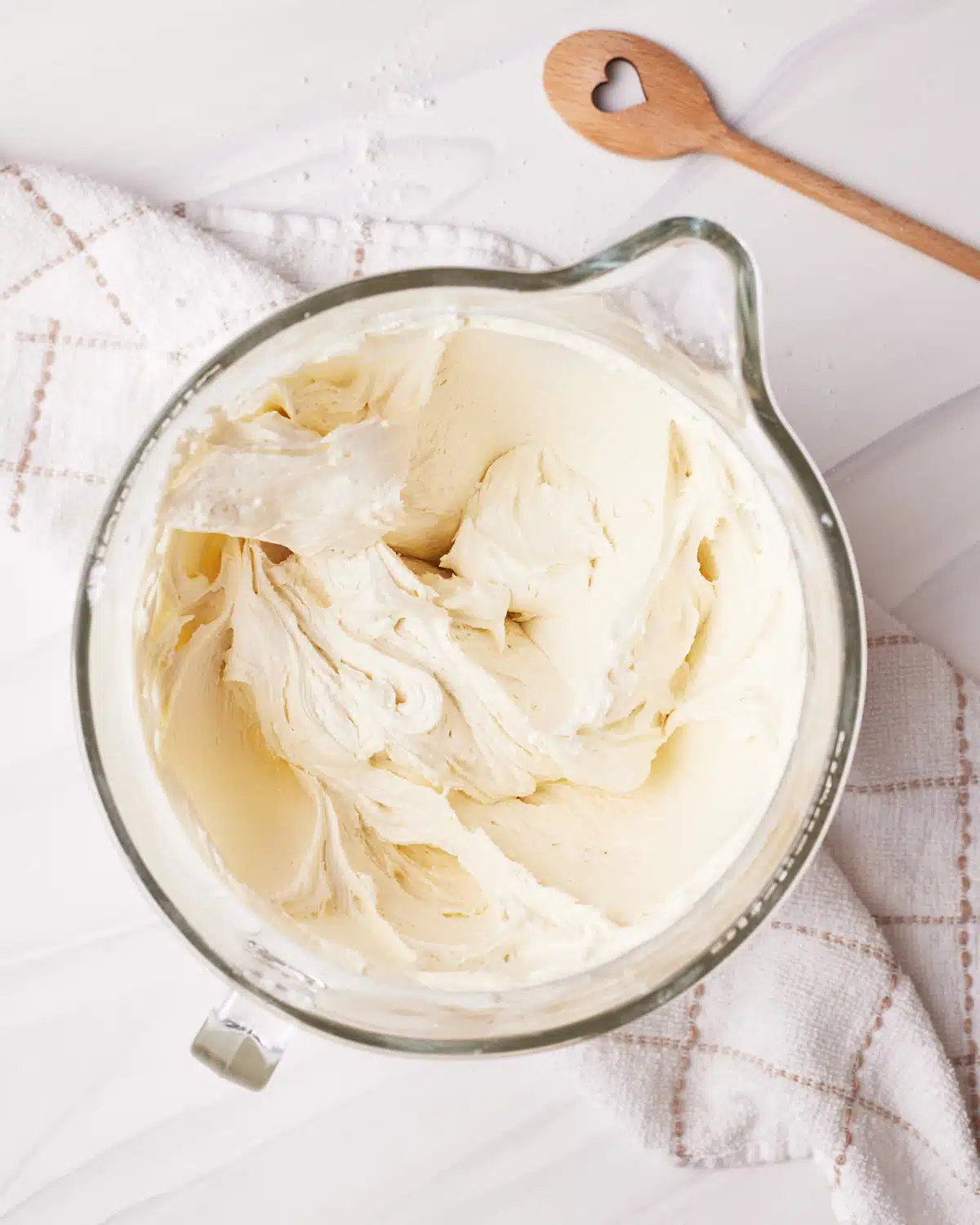
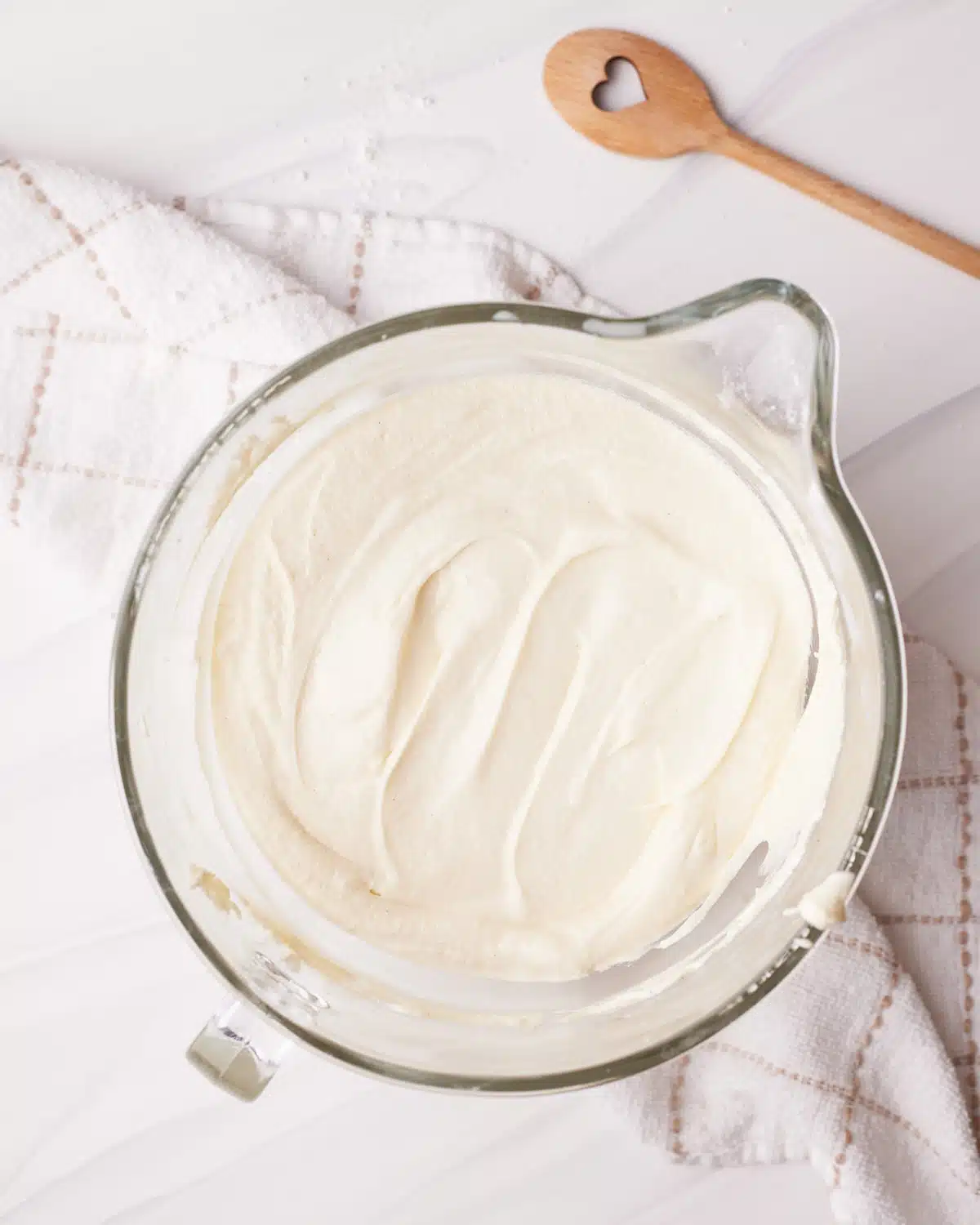
- Divide the batter into the prepared cake pans and bake for 30-40 minutes or until a skewer comes out clean.
- Let cool in the pan for at least 30 minutes before removing and putting on a wire rack to cool.
Tip: I always recommend weighing your ingredients with a kitchen scale, rather than using measuring cups. It's very difficult to measure accurately with cups and this can mess up your bakes.
Make the Custard Buttercream
This Custard buttercream, or 'German Buttercream' is silky smooth and full of rich, creamy vanilla flavor.
- Before you start, move roughly ⅓ of the pastry cream into a separate bowl and place it back in the fridge. Put the remaining ⅔ of the pastry cream in a covered bowl on the counter to come to room temperature. At the same time, remove your butter from the fridge so it can also come to room temperature.
- Once it's at room temperature, you can start making the frosting. Place all the butter in your stand mixer and beat with a whisk attachment on high speed until pale and fluffy (about 3-5 minutes)
- Add the pastry cream one tablespoon at a time until it is all added, whipping in between additions.
- Add the vanilla and salt and mix in.
- At this stage, taste-test the buttercream to see how much sweetness you would like to add. Add the powdered sugar a little at a time, whipping after every addition, until the desired sweetness is reached.
- The custard buttercream should be lovely and silky smooth - if it curdles it's usually just a sign that the ingredients were not the same temperature - to fix it just take the bowl and very gently heat the bottom of it over a bain marie and whisk until it comes together again (it shouldn't take long), then return to the stand mixer and it should be beautifully silky again!
Assemble the Custard Cake
- Once completely cooled, cut each of the cakes in half so you should have four thin cake layers. I use this cake leveler, but you can also use a serrated knife.
- Start building your layers, first with cake, then a layer of custard buttercream, smoothing it out as you go. Add your second layer of cake on top and put on a slightly thinner layer of custard buttercream.
- On top of the thinner layer of custard buttercream, pipe a border of buttercream around the outside of the middle layer, and fill the middle with half of the cold custard you reserved in the fridge. Add the next layer of cake on top
- Add another generous layer of buttercream, followed by your final cake layer. Decorate the cake however you like - smooth, naked, semi-naked, or messy. Pipe some rosettes around the top of the cake and then pour the remaining custard on top of the cake, in the middle of the rosettes.
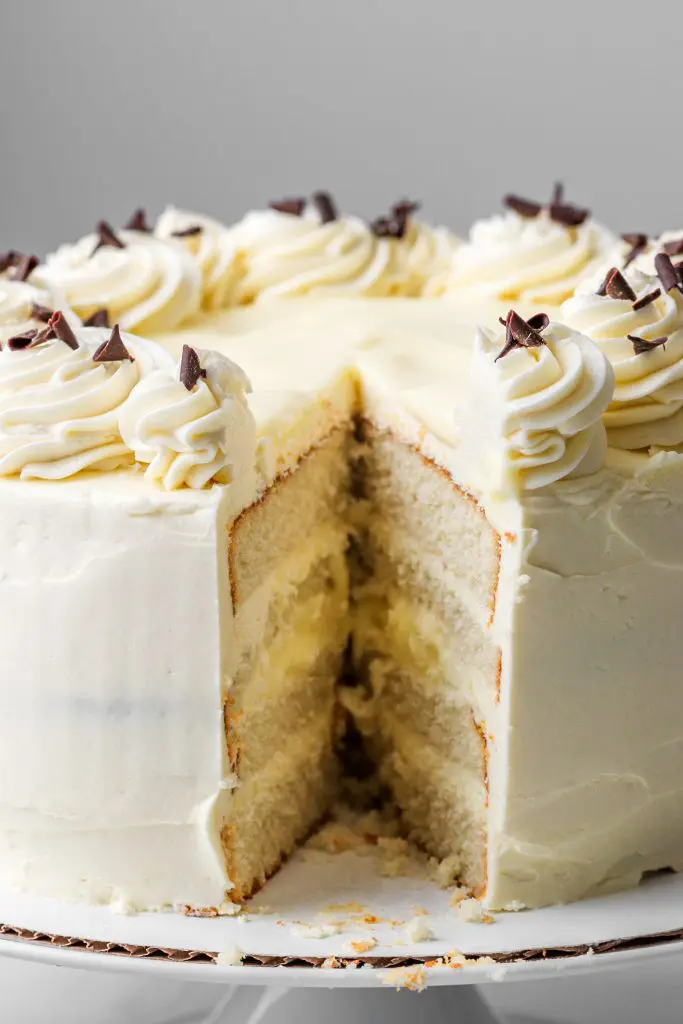
Video - Custard Cake Tutorial
Watch my full step-by-step tutorial video on how to master this custard cake.
P.S. Subscribe to my Youtube channel for future video updates!
What is the Reverse Creaming Method?
The reverse creaming method basically takes everything you know about mixing cake ingredients together and flips it on its head! The result is a beautifully tender crumb that just succumbs to your fork as you go to take a bite. I knew I needed this cake to be as soft as clouds so that you could really appreciate the texture of the custard inside it.
Reverse creaming involves mixing your dry ingredients first, then slowly adding the butter into them to coat the flour in butter - this stops the gluten from forming, making the end result beautifully soft.
Then you add the wet ingredients and beat the mixture to develop a little gluten - just enough so the cake slices will have some structure! I use this method for a few of my other recipes, like my Berry Chantilly Cake and Mango Cupcakes. It's a completely different approach to mixing ingredients, but it gives an incredible result!
What makes this Custard Cake Custardy?
There are three main components to this custard cake: the vanilla sponge, the crème pâtissière filling, and the custard buttercream.
Vanilla Cake - Firstly, the sponge is flavored with vanilla - which many people mistake as being a 'plain' flavor - but it's not! Vanilla is actually an exotic and complicated flavor profile and is the foundation for a really good custard.
Creme Patissiere - Creme patissiere or pastry cream is basically custard. But it's made properly, not out of the custard powder you can buy in a store. It is the foundation for many French pastries and can be used by itself, like in crème brûlée, or to fill tarts, pastries, and other desserts. I also use it in my Strawberry Custard Tarts, and those are ALWAYS a huge hit!
Custard Buttercream - Custard Buttercream or German Buttercream is mostly comprised of whipped butter and custard. It's a traditional frosting for many German goodies and makes for a frosting that is sweet, creamy, and silky. I highly recommend it for any custard lovers.
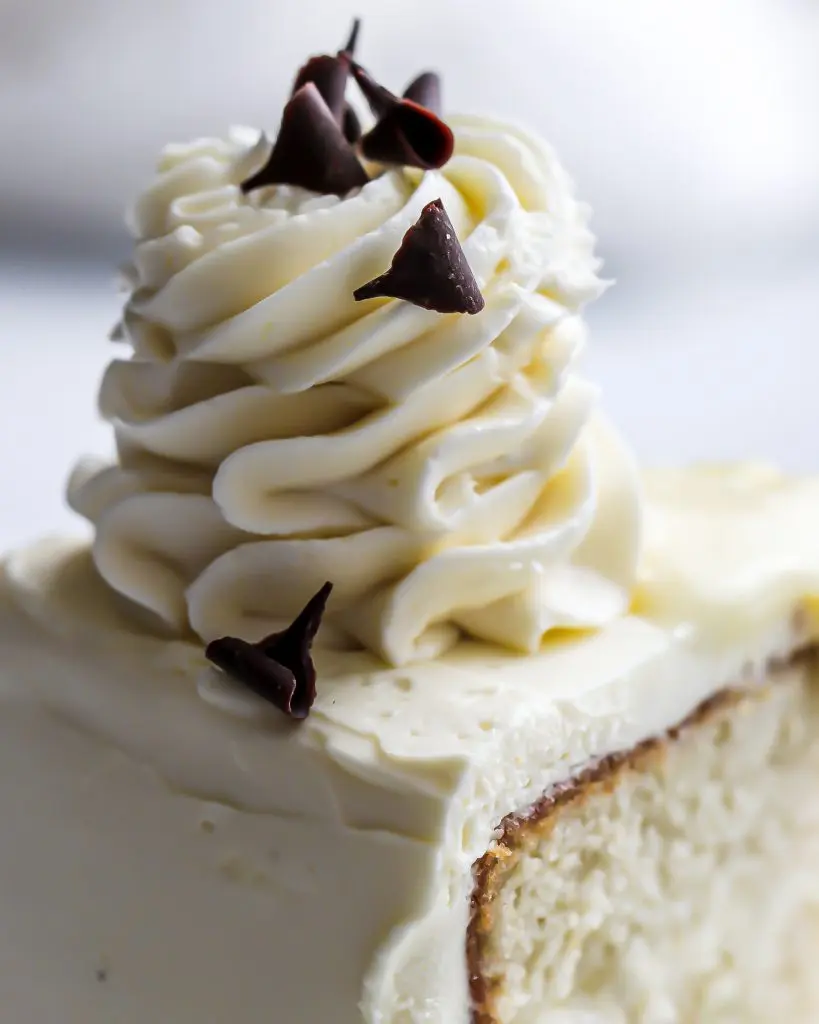
How To Store Custard Cake
The custard needs to be stored in the fridge as it contains dairy, so you'll want to keep your custard cake refrigerated in an airtight container. It will store like this for up to 4 days.
More Custard Dessert Recipes
If you are a custard lover, you may enjoy some of these custard recipes!
Recipe
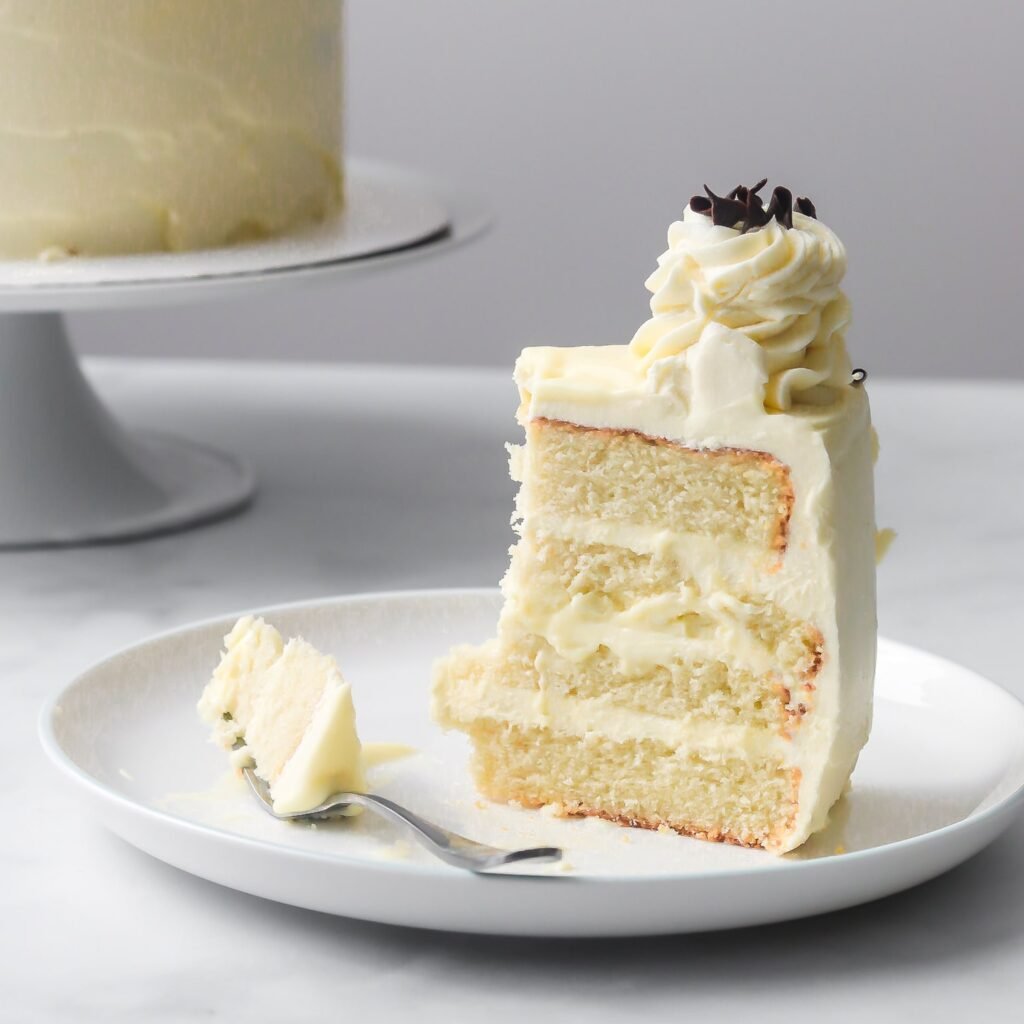
Custard Cake Recipe
Ingredients
- 3 cups Whole Milk 710g / 720ml
- 1 tablespoon Vanilla Extract
- 7 Egg Yolks
- ¾ cup Granulated Sugar 150g
- 6 tablespoon Cornstarch
- 1 ½ sticks Unsalted Butter 170g
- 1.25 cup Whole Milk 300g / 300ml
- ⅓ cup Vegetable Oil 66g / 80ml
- 3 Large Eggs
- 2 ¾ cups Cake Flour 312g
- 1 ¾ cups Granulated Sugar 350g
- 1 tablespoon Baking Powder
- ½ teaspoon Salt
- 1 teaspoon Vanilla Extract
- 2 sticks Unsalted Butter 227g
- Vanilla Pastry Cream (⅔ of the pastry cream prepared for the filling)
- 4 sticks Unsalted Butter 454g
- ⅓ cup Powdered Sugar 38g
- 1 teaspoon Vanilla Extract
- ¼ teaspoon Salt
Equipment
Instructions
- Make the pastry cream 2 - 24 hours ahead of time, as it needs time to cool and thicken. Use the steps below or see my Vanilla Pastry Cream post for more detailed instructions and process pictures.
- Put the egg yolks in a bowl with the sugar and cornstarch- whisk to combine until pale and thick.7 Egg Yolks, ¾ cup (150 g) Granulated Sugar, 6 tablespoon Cornstarch
- Put the milk and vanilla in a saucepan over medium heat until it is scalding hot. This means you can see steam rising from it and tiny bubbles appearing on the surface. Don't let it boil.3 cups (720 ml) Whole Milk, 1 tablespoon Vanilla Extract
- Drizzle a small amount of hot milk into the egg yolk mixture and whisk, then add a little more, and repeat until everything is together in the bowl. It's important to do this slowly and gradually so you don't scramble the eggsPour the whole mixture back into the saucepan.
- Return to the heat, whisking constantly until it begins to boil. Boil for 1-2 minutes or until you see thick bubbles bursting on the surface. It should be thick enough that you can draw a line in it on the back of a spoon - if it isn't, keep boiling until you reach that stage. Remove from the heat.
- If done gradually, there shouldn't be any lumps in the custard, but if there are, you can pass it through a fine mesh sieve to remove them.
- Whisk in the butter one small piece at a time, making sure it melts into the mixture completely before adding the next piece1 ½ sticks (170 g) Unsalted Butter
- Cover with plastic wrap (make sure the plastic wrap is touching the surface of the pastry cream to prevent a skin from forming) and refrigerate for at least two hours. I like to make this the day before and let it sit overnight, but it can be used after 2 hours.
- Preheat oven to 350°F/180°C (160°C for fan-assisted) and grease two 8-inch cake pans. Ensure the butter, eggs, and milk are at room temperature before beginning.
- Split the milk into two containers, one with ½ cup of milk (118g) and one with ¾ cup of milk (177g).1.25 cup (300 ml) Whole Milk
- Mix the ½ cup of milk with the vegetable oil and set aside.⅓ cup (80 ml) Vegetable Oil
- Mix the remaining milk with the eggs and vanilla. Whisk together lightly and set aside.3 Large (3) Eggs, 1 teaspoon (1 tsp) Vanilla Extract
- Place the flour, sugar, baking powder and salt into the bowl of your mixer and turn on low with your paddle attachment2 ¾ cups (312 g) Cake Flour, 1 ¾ cups (350 g) Granulated Sugar, 1 tablespoon Baking Powder, ½ teaspoon (½ tsp) Salt
- Slowly add the butter, one small chunk at a time. Once it's all in, it should look kind of like chunky breadcrumbs2 sticks (227 g) Unsalted Butter
- Add the milk/oil mixture and slowly turn your mixer up to a medium speed. Beat for exactly two minutes
- Scrape the sides of your bowl to make sure there are no lumps, then turn the mixer back on low.
- Add the milk/egg mixture slowly and mix on low until just combined.
- Divide into cake pans and bake for 30-40 minutes - check to see if a toothpick comes out clean before removing from the oven. Let the cakes cool in the pan for at least 30 minutes before removing them.
- About an hour before you start, move roughly ⅓ of the pastry cream into a separate bowl, cover with plastic wrap and place it back in the fridge. Put the remaining ⅔ of the pastry cream in a covered bowl on the counter to come to room temperature. At the same time, remove your butter from the fridge so it can also come to room temperature.
- Once it's at room temperature, you can start making the frosting. Place all the butter in your stand mixer and beat with a whisk attachment on high speed until pale and fluffy (about 3-5 minutes)4 sticks (452 g) Unsalted Butter
- Add the room temperature pastry cream one tablespoon at a time until it is all added, whipping in between additions.(1 batch) Vanilla Pastry Cream
- Add the vanilla and salt and mix in.1 teaspoon Vanilla Extract, ¼ teaspoon (¼ tsp) Salt
- At this stage, taste-test the buttercream to see how much sweetness you would like to add. Add the powdered sugar a little at a time, whipping after every addition, until the desired sweetness is reached.⅓ cup (38 g) Powdered Sugar
- The custard buttercream should be lovely and silky smooth - if it curdles, it's usually just a sign that the ingredients were not the same temperature (see notes for how to fix it).
- Once completely cooled, cut each of the cakes in half so you should have four thin cake layers. I use this cake leveler, but you can also use a serrated knife
- Start building your layers, first with cake, then a layer of custard buttercream, smoothing it out as you go. Add your second layer of cake on top and put on a slightly thinner layer of custard buttercream.
- On top of the thinner layer of custard buttercream, pipe a border of buttercream around the outside of the middle layer, and fill the middle with half of the cold custard you reserved in the fridge. Add the next layer of cake on top
- Add another generous layer of buttercream, followed by your final cake layer. Decorate the cake however you like - smooth, naked, semi-naked or messy. Pipe some rosettes around the top of the cake and then pour the remaining custard on top of the cake, in the middle of the rosettes.
Video
Nutrition
Notes
It's best to make the pastry cream in advance so it has time to cool for at least 2 hours, but you can also make it the day before. *If your buttercream curdles - take the bowl and very gently heat the bottom of it over a bain marie and whisk until it comes together again (it shouldn't take long), then return to the stand mixer and it should be beautifully silky again!


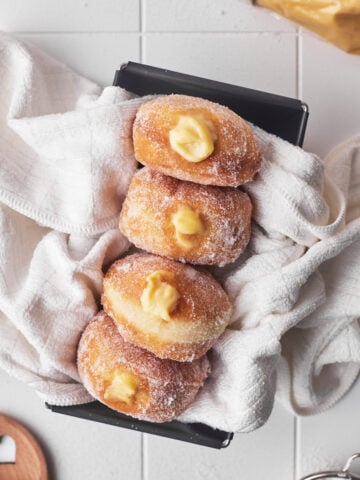
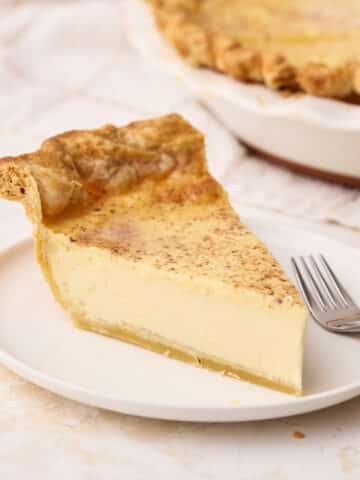
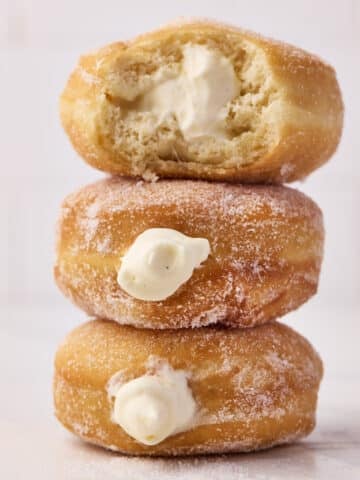
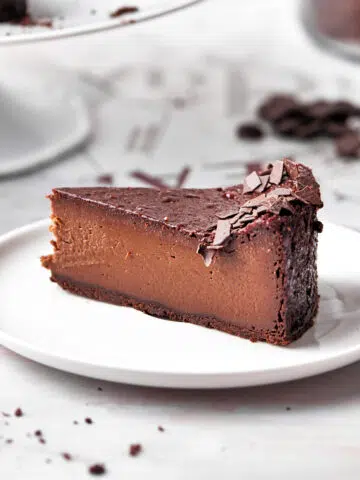

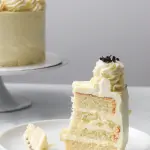
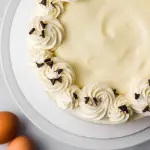
Rob
Just made this for my wife’s 40th birthday party yesterday, and it was a huge hit! When my wife asked for a vanilla cake with custard filling and vanilla icing a week ago I wasn’t sure I’d be able to pull it off. Luckily this recipe and watching the accompanying video came to my rescue! While I made a vanilla buttercream icing instead of the custard one (though I did add some custard to it), I followed the rest of the instructions religiously. The cake was a delicious success with all of the family commenting how good the cake was! So thanks for helping me make my wife’s birthday cake wish come true!
Bonnie
Of all the cakes I have baked, and there have been many, this may be the best. And it only improves with time. It's worth every step. I'm going to try a lemon version for a lemon lover's birthday today.
Beth
Excellent cake. The first time I made this was for my son’s birthday everyone enjoyed it. The following year. My son requested I make it again! It will be our annual tradition. One question I do not have an 8 inch pan cake pan. And they are hard to fine. How do I adjust for 9 inch?